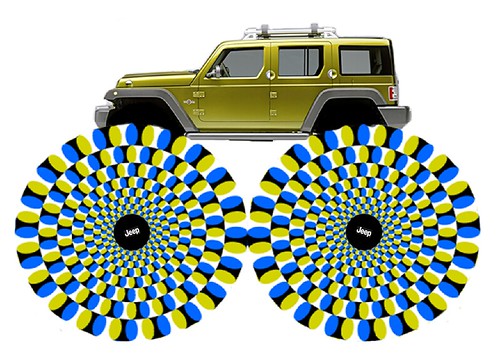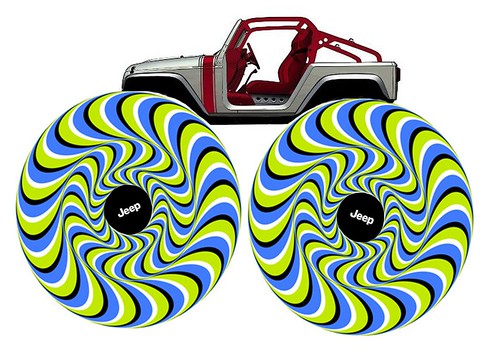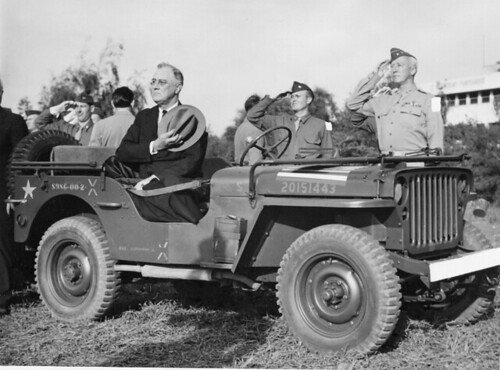- The relatively lightweight doors are removable for open-air driving, and lighter weight doors require more effort to close.
- Keeping things simple, Wrangler doors only utilize a check strap in lieu of a heavy mechanical system which aids in closing effort.
- The door opening has no weather seal so you have a clean opening for entry and exit from your Wrangler. The door has a seal with some rubber inserts that helps keep out the wind and water in some challenging locations, such as where the windshield header, hardtop Freedom Panel and door all come together.
This is where you try to paint yourself in a box. That's not going to happen here. Sometimes I wander beyond the lines of a typical copywriter. I dabble in content strategy, search, etymology, branding, research, history, green technology, alternative fuels - and a whole lot more. Hope it's an enjoyable read.
Friday, May 24, 2013
Jeep Wrangler Doors Hard to Close?
Once in a while I run into someone who shares that their Wrangler doors are hard to close. I just smile. That's a good thing. It tells me their new to the whole Jeep thing and just need a little insight to why Wrangler doors are different. In a Wrangler form follows function. There are many unique features on a Wrangler / Wrangler Unlimited with a hardtop that set it apart from all other vehicles:
Monday, May 20, 2013
Jeep Wrangler LED Modification - Cylon
This truly is a Knight Rider! Chris Knight took a 25 "pixel" LED light strip and modified his Wrangler with a Cool Neon Total Control Lighting Developer’s Shield Box.
You can find the full build guide at the instructables site.
Labels:
Cool Jeep,
Cool Neon,
Cylon,
Grille,
Instructables,
Jeep,
Jeep Neon,
KITT,
Knight Rider,
LED,
LED Strip,
MAKE,
Modification,
Shield Box,
Wrangler
Thursday, May 9, 2013
DIY Hacks & How To's: Emergency Power from a Land Line
What do you do when a hurricane creates havoc and you have no power and your smartphone is dead? As long as the phone lines are working you can charge your smartphone with a few simple items from RadioShack. MAKE magazine http://blog.makezine.com/2013/05/06/how-to-get-emergency-power-from-a-phone-line/
gives the full instructions on YouTube and also in their magazine.
http://blog.makezine.com/2013/05/06/how-to-get-emergency-power-from-a-phone-line/
Full instructions can be found at http://www.instructables.com/id/How-to-Get-Emergency-Power-from-a-Phone-Line/
Labels:
Adapter,
Be Prepared,
DIY,
Emergency,
Emergency Power,
Hack,
How To,
Hurricane,
Instructables,
Land Line,
Make magazine,
Phone Line,
Preparedness,
Smartphone
Wednesday, May 8, 2013
Jeep Rescue Optical Illusion
I created a mash-up in PhotoShop of the Jeep Rescue Concept Vehicle and some tires & wheels that have a life of their own. Hope you enjoy this fun Jeep optical illusion.
Labels:
Concept,
Concept Vehicle,
Creative,
Fun,
Illusion,
Jeep,
Jeep Adventure,
Jeep Brand,
Jeep Creative,
Jeep Fun,
Jeep Rescue,
Jeep Tires,
Marketing,
Optical,
Optical Illusion,
Photoshop,
Rescue
Jeep Wrangler Pork Chop Optical Illusion
I thought the Jeep Wrangler Pork Chop concept vehicle by Mopar could use some new psychadelic tread. Hope you enjoy my down-and-dirty optical illusion PhotoShop mash-up!
Monday, May 6, 2013
Tucker Combat Vehicle – A Unique Wheeled Fortress
Check out these amazing videos of the Tucker Combat Vehicle
(TCV). It certainly has many features that were advanced for the World War II
era. If you’ve seen Francis Ford Coppola’s movie “Tucker: the man and his dream”
– you’ll realize the man was a genius of design and innovation.
Tucker saw that war was on the horizon in Europe and began
designing for a high-speed armored combat vehicle as early as 1939. Tucker was
born in 1903 on a Michigan peppermint farm. Tucker returned to Michigan and worked
out of a barn in Ypsilanti to develop his ingenious inventions.
Some of his
unique creations include the use of individual wheel brakes – what we refer
today as Antilock Brakes or Brake Lock Differentials (03:54 mark), arc welded steel armor plate (00:08), same-size swappable bulletproof windows (00:28 mark), air
conditioning in the battlefield (09:21), bulletproof and multi-chambered radiator (01:25 mark), adjustable headlights (00:53), and a V-style hull to protect gas tank (10:09).
The Tucker Combat Car also had one of the most wicked camo paint jobs around.
Highlights from the 1942 video clip regarding the Tucker
Combat Vehicle:
“It is constructed entirely of steel armor plate, welded
together by a new method which completely eliminates all riveting.
“Large windshield and windows of bulletproof glass afford
exceptionally wide and unobstructed vision and can withstand heaviest machine
gun fire.
“All windows are of one size and instantly changeable.
“Specially designed headlamps, also of bulletproof glass, are
capable of throwing a beam one mile and are individually adjustable so as to be
usable as searchlights.
“Quickly removable hood gives complete accessibility to
engine.
“The bulletproof radiator shield is so designed that it need
not be closed. Each section can be instantly replaced when damaged.
“The huge pneumatic tires are completely bullet-proof, each
capable of withstanding fifty caliber- .50 machine gun bullets.
“The Combat Car is capable of speeds in excess of 100 miles
per hour on paved highways and 65 miles per hour over rough terrain.
“Because of advanced chassis construction, it can withstand
heaviest strains and shocks of rough terrain.
“Its low center of gravity assures perfect stability up to 45
degrees tipping angle.
“Individual wheel brakes eliminate spinning wheels.
“The Combat Car is armed with a forward battery of three
machine guns and an American Armament of 37-mm. anti-aircraft gun or anti-tank
gun, mounted in a revolving turret.
“This armament is capable of laying down a withering fire at
the combined rate of 2,820 shots a minute.
“The turret gun has a 360°
traverse and a 75°
angle of elevation.
“The unit can also be furnished with electric controls in
place of, or in addition to, manual elevating and traversing controls. The
electric device has a speed range from creeping motion to 360° in
4.6 seconds.
“It is fully automatic and fires 37-mm. explosive projectiles
against airplanes or armor-piercing projectiles against tanks.
“Bracketing and hitting aerial targets. Note tracer which
indicates path of projectile.
“Demonstrating efficiency of its armor-piercing projectiles
against steel armor plate.
“Perfect visibility enables drivers to avoid tank traps and
defenses.”
“Forced air conditioning eliminates crew discomfort and
dangers of flame attack.”
“Perfect spring suspension affords maximum riding comfort
and stability, assuring high accuracy of fire while in motion.”
“The crew is fully protected against any explosion of the
gasoline tank by heavy armor plate and by a device which directs the force of
explosive outward.”
“Engine compartment louvres are so placed as to act as
windshield defrosters.”
“The Combat Car has a 12-inch clearance and its bottom is
completely armor plated against bombardment or damage from attacks.”
“The unit has provisions for dual rear wheels, four-wheel
drive and caterpillar tracks.”
“A fleet of Combat Cars at Rahway plant, fully tested and
ready for delivery.”
Testing of the TCV was done at the Rahway, New Jersey
factory owned by the
American Armament Corporation. Harry Miller, a Tucker
employee would take some of Tucker’s suspension designs and apply them at
Bantam where he helped in the development of the first Jeep prototype vehicle.
Sadly Tucker’s original fast-moving armored car design
wasn’t mass-produced because the Belgian government that commissioned his
services was invaded by the Nazis before production could begin. The U.S.
Military rejected the concept because it was too fast to be safe. In addition
the contracts were already awarded by the time they tested the vehicle.
According to LEF magazine His revolutionary plexi-glass gun turret that was eventually used on the B-17
Flying Fortress, the B-24 Liberator and other American bombers. The “Tucker
Turret” was even used by the Navy on many of its PT boats and landing ships.
Labels:
Anti Aircraft,
Combat Car,
Combat Vehicle,
design,
Innovation,
Military,
Tank,
Tucker,
Tucker Combat Car,
Tucker Tiger,
Tucker Turret,
Turret,
US,
World War Two,
WWII
1978 Jeep Expedition of the Americas - Jeep Song
A song at the 16:14 mark carries the message though of this amazing adventure:
There’s a spot that finds its way
into a special kind of man
that lights a fire deep in his soul
that tells him “yes you can.”
He can get out from behind his desk
And go try something new
Driving up the side of the world
Is just the thing to do.
Cause he’s driven by a dream
A rainbow is his guide
He get’s his strength from mother earth
And a billion starry lights
He’s driven by a dream
Crossing rivers, climbing trees
To turn the heartaches and the joys
Into treasured … memories.
This spark becomes a torch
And is passed from man to man
You can see it in their faces
As they go lend a hand
Each step makes him taller
And fills his heart with pride
When your driving up the side of the world
You take it all in stride
Nissan DeltaWing as Sleep Aid
Labels:
Concept,
Delta,
Delta Wing,
DeltaWing,
Endurance,
Engine,
Future,
Guilt Free,
Guilt Free High Performance Motoring,
Innovation,
LeMans,
Motoring,
Motorsport,
Nissan,
Racing,
Sleep Aid,
Technology,
Wing
Thursday, May 2, 2013
Roosevelt and General Patton Jeep
Found this wonderful shot of President Franklin D. Roosevelt seated in a Jeep with hat over his heart. General George Patton can be seen saluting the flag on the other side of the Jeep vehicle. Photo was taken in Casablanca on 01/18/1943. I touched up the dust spots from the original.
Courtesy of the Franklin D. Roosevelt Presidential Library.
Courtesy of the Franklin D. Roosevelt Presidential Library.
Subscribe to:
Posts (Atom)






















